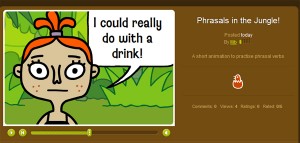Part of the Cool Sites series
An Xtranormal Kind of Introduction
Teaching phrasal verbs is my favourite activity of all! Why is this so? Well, in my experience, I have found that students generally don’t like studying them because they find them “too difficult, miss!” I set out from elementary level to train my students not to be afraid of them, but to look forward to showing off their newly acquired knowledge of them. To stand out from the crowd. To use phrasals in a natural way. In the correct context. How do I do this? I will explain.
I encourage them to chill out during the lessons if I see they look a bit stressed out. I ask them to come up with ways of using new phrasals both in class and outside of class. I encourage them to ask each other this question as a natural starter “Have you come across this word? Do you know what it means?”, if for example, they don’t know the meaning of a word. Instead of asking me all the time, students are encouraged to ask each other first, always using this phrasal verb until it becomes instinctive for them and of course, second nature. On a Monday morning my first question is inevitably “What did you get up to over the weekend?” Students then ask each other in pairs and dialogue ensues following this prompt. Another question would be “Did you get through the weekend homework?” I make sure that these questions are all in context and provide opportunities for practice.
Slideshare
Below is an example of a Powerpoint presentation converted to Slideshare. I have created this in order to maximise opportunities for student discussion. This would either be used as an introduction to this set of verbs, or as a review and recycling activity. I have introduced 18 phrasal verbs with some follow-up activities at the end. I have experimented with whole pictures as background for added interest.
Bookr
Bookr by Pim Pam Pum is a nice tool for exploiting images to enhance your phrasal verbs lessons. You can easily create a “book” in minutes by selecting pictures, according to the theme you want to explore, and then simply dragging them into the pages of the book. You can write a short sentence on each page. The example below is one I created especially for this post to demonstrate how it can be used.
Dvolver
This is a great site for dialogue exploitation. The animations are easy to create with a set group of characters. There is a choice of background music which adds to the special effects. There is no sound for the characters.
Go!Animate
This is another cool site for creating animations. Go!Animate can be used by students to recycle phrasal verbs learned or indeed, any item of vocabulary that needs to be reviewed.
GoAnimate.com: Getting Down to Phrasals by Janet Bianchini
Create your own at GoAnimate.com.
The ZimmerTwins
I registered on the ZimmerTwins site for the purpose of researching for this post. I was surprised at how intuitive and easy it was to create my very first animation. I have a feeling that students will love this tool!
Have a look at Phrasals in the Jungle!
ToonDo
I love ToonDo because it’s easy to create cartoons for any topic you like. Students enjoy creating small dialogues or comic strips. Here’s one I created which has a phrasal verbs theme. The cartoons can be easily embedded into your class / student blogs or posted via email.

Create your own Toon!
PhotoPeach
The last on my list of favourite e-tools to make teaching and learning phrasal verbs fun is PhotoPeach. I was able to create a simple quiz using my own photos. You have to select a synonym out of the 3 options given for the verb in the picture. I hope you enjoy it!
Test your Phrasals! on PhotoPeach
Challenge
I hope I have inspired you to use some of these cool sites with your students. You can adapt them to suit whatever theme you are working with. Why don’t you try one of these out for your next class? I am sure your students would enjoy creating short animations and dialogues or short books or indeed quizzes to test each other on new vocabulary or structures they have learned with you.
Have you had experience with any of these tools? If so, I would love to hear from you to learn how you and your class got on with them!
—————————————————-
 I would like to thank Shelly for giving me this wonderful opportunity to write for her Cool Sites series. It’s a great honour for me to be here.
I would like to thank Shelly for giving me this wonderful opportunity to write for her Cool Sites series. It’s a great honour for me to be here.
Janet Bianchini (@janetbianchini) has been an EFL teacher for over three decades. She still loves teaching and she is enjoying the challenge of learning more about new technologies and how to integrate them into her lessons. She writes a blog called Janet’s Abruzzo Edublog. When she is not writing, studying or teaching, she loves to spend time in her rather wild garden with her menagerie in tow.








